#electrochemical stability
Text
Of particular interest are room-temperature ionic liquids because of their negligible vapour pressure, low toxicity, high chemical and thermal stability, high conductivity, significant electrochemical stability and ability to dissolve a wide range of compounds.
"Chemistry" 2e - Blackman, A., Bottle, S., Schmid, S., Mocerino, M., Wille, U.
#book quote#chemistry#nonfiction#textbook#room temperature#ionic liquid#vapor pressure#toxicity#chemical stability#thermal stability#conductivity#electrochemical stability#dissolved
0 notes
Text
Carbon Conundrum: Unraveling the Mysteries of Cyclo[18]carbon and Beyond

In 2019, the groundbreaking synthesis of cyclo[18]carbon, a novel isomer of carbon with an alternating single-triple bond arrangement in an 18-membered ring, created a sensation in the scientific community. Initially obtained through electrochemical decarbonylation of cyclobutadione by a collaborative effort between IBM and Oxford University, this molecular marvel defied thermodynamic stability expectations. The research was hailed as a star molecule by the American Chemical Society's C&EN magazine.
Recently, breaking the theoretical limit, Professor Wei Xu's team at Tongji University reported the synthesis and characterization of two new carbon forms, cyclo[14]carbon and cyclo[10]carbon, shedding new light on the properties and structures of controversial all-carbon rings.
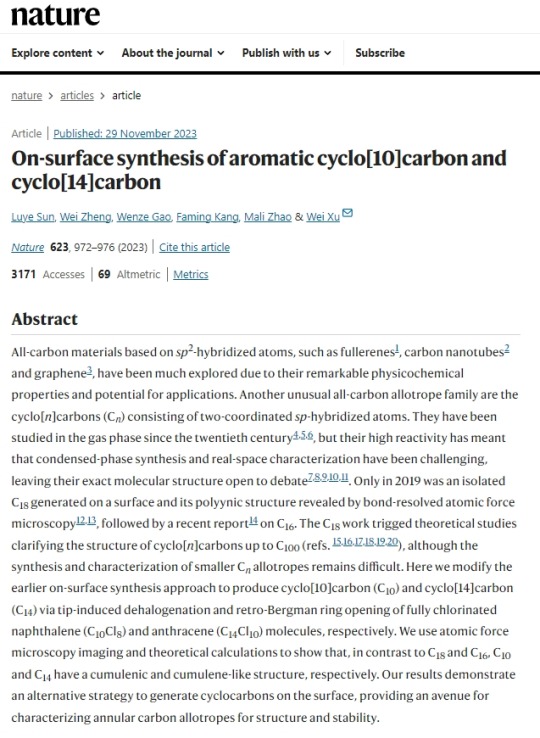
Nature highlighted these achievements with the headline 'Carbon rings push limits of chemical theories,' recognizing the groundbreaking nature of the discoveries.

11 notes
·
View notes
Text
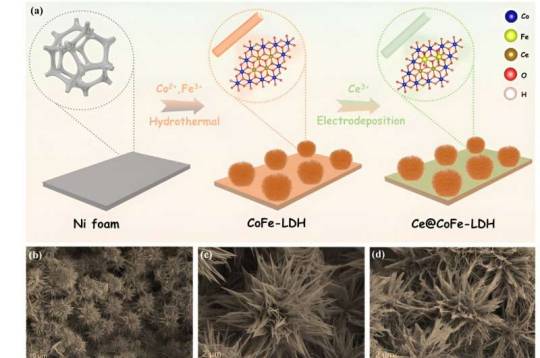
Urchin-like CoFe-layered double hydroxide synthesized for high-efficiency electrocatalytic oxygen evolution
A research team led by Professor Wang Qi from Hefei Institutes of Physical Science, Chinese Academy of Sciences, has successfully synthesized a heterogeneous Ce@CoFe-LDH electrocatalyst by combining a simple hydrothermal method with rapid electrodeposition.
The results were published in Inorganic Chemistry Frontiers.
Electrochemical water splitting is vital for clean hydrogen energy production. The oxygen evolution reaction (OER) in water splitting is slow due to complex electron transfer steps. Noble metal-based nanomaterials like Ru or Ir are effective OER catalysts but face scarcity and stability issues. Developing stable OER electrocatalysts based on transition metals is crucial for large-scale applications.
Read more.
6 notes
·
View notes
Photo
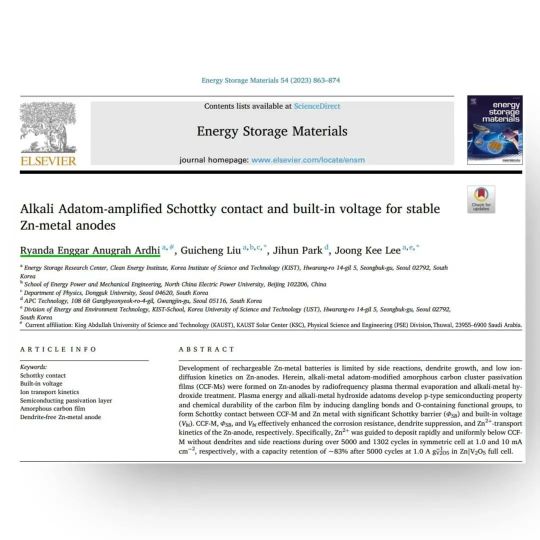
Bismillahirrahmanirrahim. Alhamdulillah. The result of my work in my last year stay at @kist_pr as a Ph.D. student (5 months) and Postdoc (7 months) just before leaving for @kaustofficial (@kaust_solar_center, , @KAUST_PSE) has just been published in Energy Storage Materials (EnSM; Q1; Impact Factor (IF) = 20,831 (2021)) entitled "Alkali Adatom-Amplified Schottky Contact and Built-in Voltage for Stable Zn-Metal Anodes", which is my 5th paper as the first author in high reputable journals in 5 consecutive years on electrochemistry-based topics (e.g., batteries, solar cells, and supercapacitors), from 16 in total (including as co-author). This work was close to being accepted in Energy & Environmental Science (EES; Q1; IF = 39.714 (2021)) and Advanced Energy Materials (AEM; Q1; IF = 29,698 (2021)). The review system used by EnSM, the "double-blind peer review process", makes the review process fairer and reduces the tendency of "conflict of interest" from reviewers to authors and vice versa because the names of the reviewers and authors are kept confidential from each other by the editor during the review processes. The study in this paper is a continuation of our previous study published in ACS Energy Letters (Q1; IF = 23,991 (2021)) last year ( https://doi.org/10.1021/acsenergylett.1c00150 ) on improving the electrochemical stability of lithium metal anodes by suppressing lithium dendrites using a Schottky contact created by a carbon semiconductor film on the anode surface. In a current study published in EnSM, we aimed to suppress similar problems (dendrites and corrosion) but on a different system, the Zn metal anode of aqueous-based zinc metal batteries, using various degrees of Schottky contact. Thanks to all authors, KIST, and my Professor for all their contributions, supports and facilities. I dedicate this work to my beloved Parents (Mother and deceased Father) and Family. Paper link: https://doi.org/10.1016/j.ensm.2022.11.031 Stay focused, keep productive, and always believe in yourself. More to come! #masyaallahtabarakallah #tabarakallah #paper #researchpaper #publication #science #research #battery (at KAUST- King Abdullah University For Science And Technology) https://www.instagram.com/p/ClpkBusIdJt/?igshid=NGJjMDIxMWI=
2 notes
·
View notes
Text
Examining Different Surface Finishing Methods
With numerous surface treatment processes out there, understanding them can be daunting. Fear not! This blog by Solid Displays breaks down complex definitions and provides process diagrams, making it a breeze to grasp various surface treatment methods in just minutes!
1. PVD (Physical Vapor Deposition)
PVD is an industrial manufacturing process, belonging to a type of coating technology, primarily using physical means to heat or excite materials to deposit thin films. This technique, also known as vacuum coating or vapor deposition, is commonly employed in surface treatments of cutting tools, various molds, and in the manufacturing processes of semiconductor devices.
AD: Compared to chemical vapor deposition, physical vapor deposition has a wider range of applications. Almost all materials can be used to prepare thin films through physical vapor deposition.
DIS: The uniformity of film thickness is indeed a concern in physical vapor deposition.
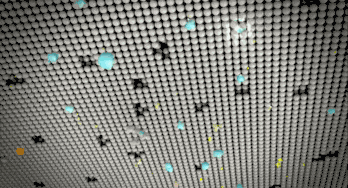
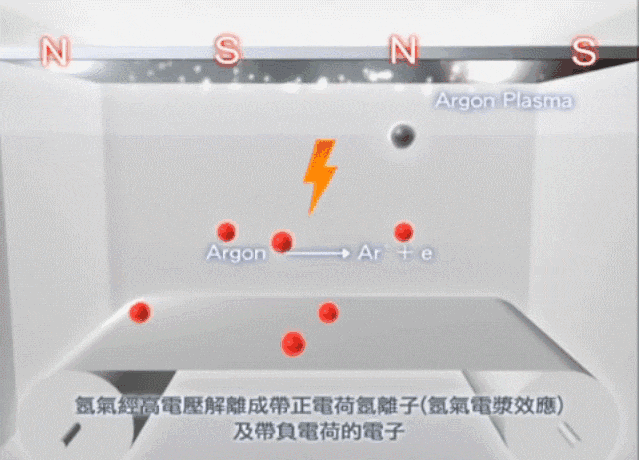
2. Mechanical Polishing
Mechanical polishing relies on the grinding and rolling action of very fine polishing particles, as well as cutting and plastic deformation of the material surface, to remove protrusions from the polished surface of the metal sample, thus obtaining a smooth surface.
AD: The equipment structure is relatively simple, and the price is generally lower compared to other methods.
DIS:
Mechanical polishing is challenging for polishing workpieces with complex shapes or surfaces featuring special patterns or textures.
It tends to generate metal dust, which can affect the health of polishing workers.
It requires a high level of skill from workers, making it difficult to control the consistency and stability of workpiece quality.
Mechanical processing inevitably leaves microscopic cracks and residual stress on the workpiece surface, which may affect the quality and lifespan of the workpiece and pose safety hazards for production.
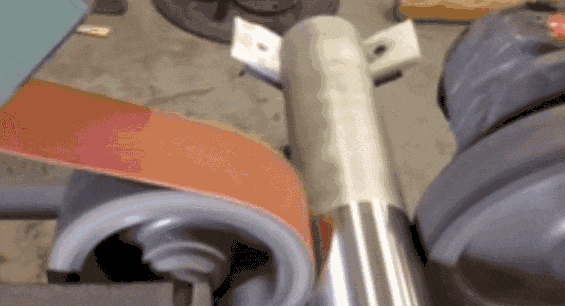
3. Chemical Polishing
Chemical polishing is a method that relies on the selective dissolution of surface irregularities on samples through the chemical etching action of chemical reagents, eliminating scratches and leveling surfaces.
AD: Chemical polishing does not require special fixtures or DC power supply equipment. It is simple to operate, energy-efficient, and not limited by the size or shape of the workpiece. Additionally, the direct cost of polishing is relatively low.
DIS: The pollution issue is particularly severe, as handling the waste liquid generated during the polishing process can increase costs.
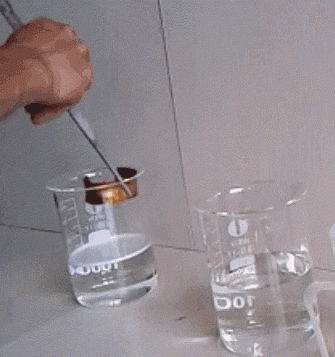
4. Electropolishing
Electropolishing, also known as electrochemical polishing or electrolytic polishing, utilizes the phenomenon of electrochemical dissolution generated by the anode in an electrolytic cell to selectively dissolve micro-protrusions on the anode surface, resulting in a smoother surface. In this process, the workpiece to be polished serves as the anode, while an inert metal acts as the cathode. Both poles are immersed in an electrolyte solution, and a direct current is passed through to achieve selective anodic dissolution, thereby increasing the brightness of the workpiece surface.
AD:
Consistent internal and external color, long-lasting luster, and the ability to smooth out concave areas that mechanical polishing cannot reach.
High production efficiency and low cost, suitable for large-scale sample preparation.
Enhanced corrosion resistance of the workpiece surface, applicable to all stainless steel materials.
DIS:
The quality of electrolytic polishing is influenced by the specifications of the electrolyte, as well as the current and voltage settings, making it difficult to determine the correct parameters.
Achieving satisfactory results for samples with cast iron or impurities is more challenging.
The electrolyte composition is complex, requiring careful attention to safety during use.

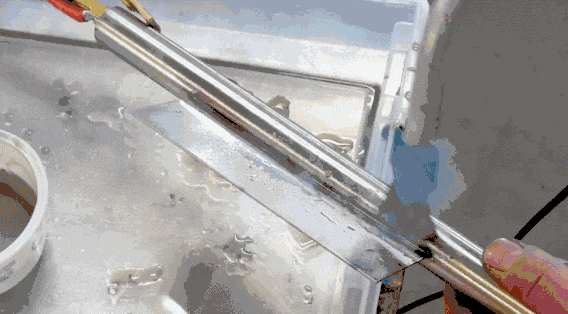
5. Spray Painting
spray painting is a coating method where the liquid is dispersed into uniform and fine droplets using a spray gun or disk atomizer, typically with the aid of pressure or centrifugal force, and applied to the surface of the object to be coated.
AD: Fast construction, good surface smoothness, no texture differences.
DIS: Spray painting machines are relatively expensive, and there is a significant amount of paint wastage.

6. Powder Coating
Powder coating is a process where powder coating material is sprayed onto the surface of a workpiece using powder coating equipment (electrostatic spray gun). Under the influence of static electricity, the powder evenly adheres to the surface of the workpiece, forming a powdery coating layer.
AD:
Powder coatings do not contain VOCs (volatile organic compounds), eliminating issues such as fire hazards, toxicity, and environmental pollution.
Minimal material loss and high utilization.
Easy control of coating thickness, high construction efficiency, low construction difficulty, and energy and labor-saving.
Scratch-resistant, impact-resistant, durable, and excellent chemical resistance.
DIS:
The investment required for manufacturing powder coatings and replacing coating equipment is significant.
Color matching for powder coatings can be challenging, and changing colors or types during coating is more cumbersome and costly.
Cannot be used on substrates with poor heat resistance such as plastic, wood, or paper.
Powder coatings are susceptible to clumping during storage due to pressure, temperature, and humidity fluctuations.

7. Sandblasting
Sandblasting, using compressed air as the driving force, involves high-speed jet streams of abrasive materials (such as copper ore sand, quartz sand, emery, iron sand, and sea sand) being sprayed onto the surface of workpieces, causing changes in the appearance or shape of the workpiece surface. Due to the impact and cutting action of the abrasives on the workpiece surface, the surface cleanliness and roughness of the workpiece are altered. This process improves the mechanical properties of the workpiece surface, enhancing fatigue resistance, increasing adhesion between the workpiece and coatings, prolonging the durability of the coatings, and facilitating coating leveling and decoration.
AD:
Sandblasting can quickly clean the surface of objects, and the surface quality after sandblasting is good, effectively prolonging the lifespan of objects.
Sandblasting can be adapted to various types of objects, whether they are made of steel, ceramic, or plastic.
Simple operation.
DIS:
Sandblasting generates a large amount of dust and waste, causing environmental pollution.
Sandblasting operations require certain knowledge and skills; incorrect operation may damage the surface of objects.
Sandblasting requires regular maintenance and cleaning to ensure its proper functioning.
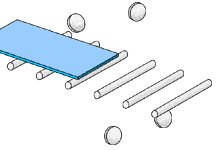
8. Shot Peening
Shot peening is a widely used surface strengthening process in factories. It involves bombarding the surface of workpieces with shot particles to implant residual compressive stress, thereby enhancing the fatigue strength of the workpiece through cold working. This technique is extensively used to improve the mechanical strength, wear resistance, fatigue resistance, and corrosion resistance of components. Types of shot particles include steel shot, cast iron shot, glass beads, ceramic beads, etc.
AD:
Simple equipment, low cost
Not restricted by the shape and position of the workpiece
Convenient operation
DIS:
Poor working environment
Low unit output
Lower efficiency compared to shot blasting
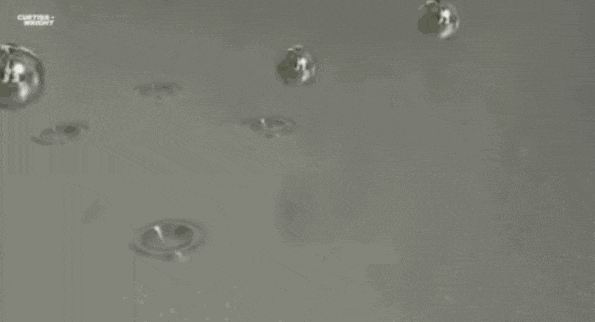
9. Electroplating
Electroplating is a process that involves using electrolysis to deposit a metal film onto the surface of metal or other material components. This process helps prevent metal oxidation (such as rusting), enhances wear resistance, conductivity, reflectivity, corrosion resistance, and improves aesthetics.
AD: Attractive surface appearance, excellent corrosion resistance, strong mechanical properties.
DIS: Improper handling of generated wastewater and exhaust may lead to environmental pollution, high energy consumption, and potential health hazards to humans.

10. Anodizing (Anodic Oxidation)
Anodizing refers to the process where aluminum and its alloys, under specific electrolyte and process conditions, form an oxide film on the surface of aluminum products (the anode) due to the action of an external electric current.
AD:
Anodizing can form a dense oxide film on the surface of metal, effectively preventing oxidation and corrosion.
It increases the hardness of the metal surface, making it more resistant to wear and scratches, thus extending its lifespan.
Different colors of oxide films formed on the metal surface enhance its aesthetic appearance and decorative properties.
The roughness of the metal surface increases after anodizing, which promotes adhesion between coatings and substrates, making the coating more durable.
An insulating oxide film formed on the metal surface improves its insulation properties.
DIS:
Particularly when dealing with large areas or thicknesses of metal products, significant energy consumption increases production costs.
Strict control of processing conditions and operating standards is required, leading to longer processing times that may affect production efficiency.
The oxide film formed during anodizing may affect the dimensions and shapes of the metal, posing a certain risk to the normal operation of high-precision or high-demand components.
The anodizing process is mainly suitable for certain metals such as aluminum, magnesium, and titanium. For other metals like steel, copper, and silver, the anodizing process may not be applicable or effective.
Although the oxide film formed by anodizing has high hardness and corrosion resistance, it may be damaged under certain conditions such as mechanical wear or chemical corrosion, requiring regular maintenance and repair.

11. EPD (Electrophoretic deposition)
Electrophoretic deposition is a process where, under the influence of an applied voltage between positive and negative poles, charged paint particles in an electrophoretic coating migrate toward the cathode. They react with alkaline substances generated on the cathode surface, forming insoluble deposits on the surface of the workpiece.
AD:
Safety in production: Electrophoretic coating uses water as a solvent, making it non-toxic and non-flammable.
High-quality coating: Electrophoretic paint has strong adhesion, uniform thickness, and excellent corrosion resistance.
High utilization rate: Electrophoretic paint is efficiently used.
DIS:
Limited applicability to small and medium-sized parts due to equipment constraints.
Restricted to conductive substrates and single-layer coating: Once a part is coated with electrophoretic paint, it becomes an insulator, preventing further electrophoretic coating.
Limited color options: Electrophoretic paint colors are predominantly dark.
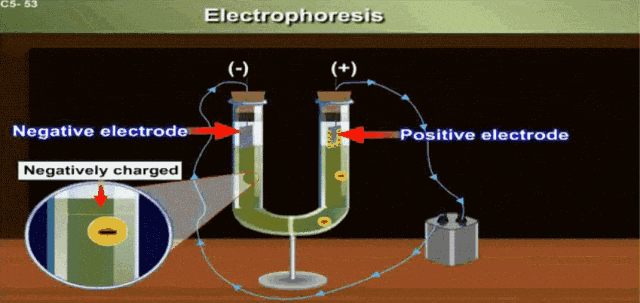
12. Micro-arc Oxidation
Micro-arc oxidation, also known as micro-plasma oxidation, is a process where, through a combination of electrolyte and specific electrical parameters, an instant high-temperature and high-pressure effect is generated on the surface of aluminum, magnesium, titanium, and their alloys via arc discharge. This process results in the growth of a ceramic coating layer primarily composed of metal oxide on the substrate.
AD:
The metal oxide layer formed by micro-arc oxidation is metallurgically fused with the substrate, resulting in high bond strength. The ceramic layer has a dense structure, good toughness, and exhibits characteristics such as wear resistance, corrosion resistance, high-temperature shock resistance, and electrical insulation. It can also meet requirements for thermal insulation, catalysis, antibacterial properties, etc.
The process has a wide range of applications and is environmentally friendly during processing.
DIS: The surface may be rough and uneven.

13. Metal Brushing
Metal brushing is a manufacturing process involving repeatedly scraping aluminum plates with sandpaper to create lines. The main process consists of three parts: degreasing, sanding, and washing. During the brushing process, a special film technique applied after anodizing treatment enables the metal surface to form a film layer containing metal components. This process makes each fine scratch clearly visible, allowing the metal to exhibit a subtle sheen amidst its matte finish.
AD:
Wear-resistant, high-temperature-resistant, and corrosion-resistant.
Easy maintenance and cleaning in daily use.
Fine texture.
Long lifespan.
DIS: Relatively expensive price.
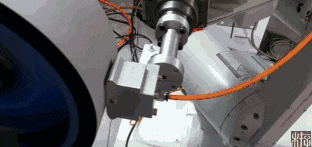
14. Etching
Etching is a technique that removes part of the material through chemical reactions or physical impacts. Etching typically refers to photolithographic etching, where after exposure and development, the protective film on the area to be etched is removed. When exposed to a chemical solution during etching, it dissolves and corrodes the material, creating a concave or hollow effect.
AD:
Metal etching processes can create extremely precise shapes and patterns, and the consistency of the metal etching process ensures that each product in mass production has the same quality and characteristics.
Etching processes can be applied to various metals, including copper, nickel, gold, silver, iron, and some non-metallic materials.
Metal etching processes generate relatively little waste, and in many cases, waste can be recycled and treated.
High efficiency.
DIS:
Etching processes require precise control of factors such as chemical solution concentration, temperature, and etching time, leading to high complexity.
High equipment and manufacturing costs: Etching processes require specialized equipment and materials such as etching tanks, power supplies, heat exchangers, etc. Additionally, precise control of the production process is needed to ensure product quality and consistency.
Workers may be exposed to hazards such as chemical substances, high temperatures, and noise.
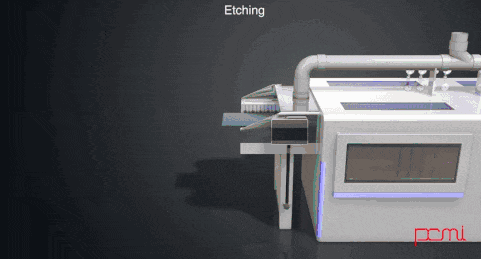
15. IMD (In-Mold Decoration technology)
IMD, also known as non-painting technology, is an internationally popular surface decoration technique. It involves applying a surface-hardened transparent film, printing the pattern layer in the middle, and injecting the back molding layer. The ink is sandwiched between layers, making the product resistant to friction, preventing surface scratches, and maintaining color brightness for an extended period without fading.
AD:
Strong scratch resistance and corrosion resistance.
Long service life.
Excellent three-dimensional effect.
Strong resistance to dust, moisture, and deformation.
Color can be changed as desired.
Patterns can be easily modified.
DIS:
Long lead time.
Prone to issues such as film detachment and distortion.
High defect rate in products.


16. OMD (Out Mold Decoration)
OMD is an extension of IMD (In-Mold Decoration) technology that integrates visual, tactile, and functional elements. It combines printing, texture structure, and metallization characteristics to achieve 3D surface decoration.
AD:
Substrate material is not limited, can be metal or plastic.
Can achieve 3D shapes.
Can encapsulate internal structures (back-molding).
Allows for simultaneous processing of multiple small products.
DIS:
High equipment investment.
Unable to achieve complex 3D shapes.

17. Laser Engraving
Laser engraving, also known as laser etching or laser marking, is a surface treatment process based on optical principles. It involves using a laser beam to engrave permanent marks on the surface of a material or within transparent materials.
AD:
Fast marking speed, low cost
Attractive patterns, high resolution, and high precision
Wear-resistant
DIS: Limited color options
18. EDM (Electrical Discharge Machining)
EDM is a specialized machining method that utilizes the erosive effect produced by pulsed discharges between two electrodes immersed in a working fluid to remove conductive materials. It is also known as spark machining or spark erosion machining. The tool electrode is typically made of materials with good conductivity, high melting points, and easy machinability, such as copper, graphite, copper-tungsten alloy, and molybdenum. During the machining process, there is wear on the tool electrode, but it is usually less than the material removal from the workpiece metal, and in some cases, it can be negligible.
AD:
Capable of machining materials and complex-shaped workpieces that are difficult to cut using conventional cutting methods, such as sharp corners.
Does not produce burrs and tool marks.
Tool electrode material does not need to be harder than the workpiece material.
Enables automation due to the direct use of electrical energy.
DIS: Low efficiency.
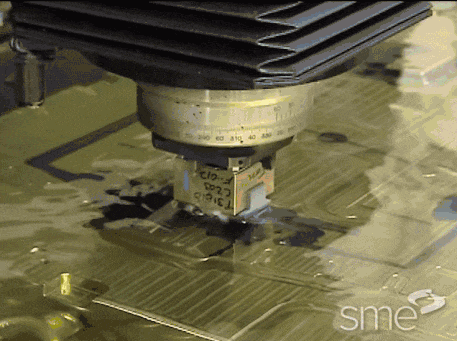
19. Laser Etching
Laser etching involves the treatment of steel surfaces with high-energy density lasers to create patterns such as snake skin, etchings, pearlescent finishes, or other forms of textures.
AD: High welding accuracy and small heat-affected zone, suitable for repairing precision molds.
DIS:
Welding wire is relatively expensive, leading to lower efficiency.
Bulky equipment makes mobility difficult, and unsuitable for on-site operations. Welding repairs need to be performed on a workbench, making it impractical for large molds or workpieces.
Repairing irregular-shaped defects can be challenging compared to straight-line repairs.
Large heat-affected zones during welding repairs increase the likelihood of workpiece sagging, deformation, and undercutting.
Lower welding accuracy, unable to meet the requirements of high-precision molds.
Many mold repairs require preheating, insulation, and other processes, making them cumbersome and time-consuming.
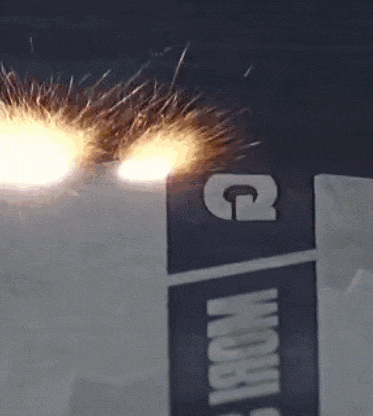
20. Pad Printing
Pad printing, also known as tampon printing, is a specialized printing method that involves using a steel (or copper, thermoplastic) plate with an engraved design. A curved surface pad made of silicone rubber material is used to pick up ink from the plate’s surface. The ink is then transferred onto the desired object’s surface by pressing the pad against it, resulting in the printing of text, patterns, or other images.
AD:
Wide application range: Pad printing is commonly used on products with recesses or on the back of objects where screen printing is not feasible. It can achieve clean printing results even on uneven surfaces.
Convenient operation: Equipment can be operated semi-automatically or fully automatically, with low labor costs and high production efficiency.
DIS:
Ordinary results.
Pad printing cannot create patterns with large areas.
Due to the clear edges of the recesses processed by steel plates, gradient colors cannot be produced.
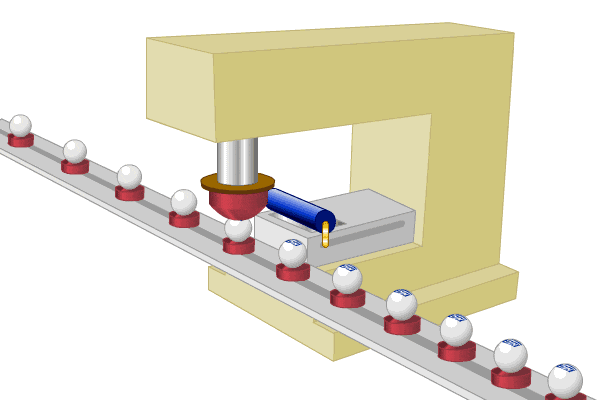
21. Screen Printing
Screen printing refers to a printing method that uses a screen as the printing plate, which is made into a screen printing plate with images or text through photosensitive plate-making methods. Screen printing consists of five main elements: the screen printing plate, squeegee, ink, printing table, and substrate. The basic principle of screen printing is that the ink can pass through the mesh holes of the image/text part of the screen printing plate, while the non-image/text part of the mesh holes cannot pass through the ink. During printing, ink is poured into one end of the screen printing plate, and a certain pressure is applied to the inked area on the screen printing plate using a squeegee. At the same time, the squeegee moves steadily towards the other end of the screen printing plate, and the ink is squeezed from the mesh holes of the image/text part onto the substrate.
AD:
Screen printing can use various types of inks: oil-based, water-based, synthetic resin emulsion-based, powder, etc.
Screen printing plates are flexible and have a certain elasticity, suitable for printing on soft materials such as paper and fabric, as well as on hard objects such as glass and ceramics.
Screen printing requires low printing pressure, making it suitable for printing on fragile objects.
Thick ink layer with strong coverage.
Not limited by the surface shape or size of the substrate. Screen printing can be applied on flat surfaces, as well as on curved or spherical surfaces. It is suitable for printing on both small and large objects.
DIS:
Only one color can be printed at a time.
Plate-making and film output costs are relatively high, making it unsuitable for small-batch production.
Poor performance when used on uneven surfaces.
Ink quantity cannot be easily controlled.

22. Direct Thermal Printing
Direct thermal printing refers to a method where a thermal-sensitive agent is coated on paper to create thermal recording paper. When subjected to heat, the thermal recording paper causes a physical or chemical change in the substance (coloring agent) to produce an image.
AD:
Fast printing speed and low noise level.
Clear printing and easy to use.
DIS: Direct thermal printers cannot print duplicates directly, and the printed documents cannot be permanently archived.
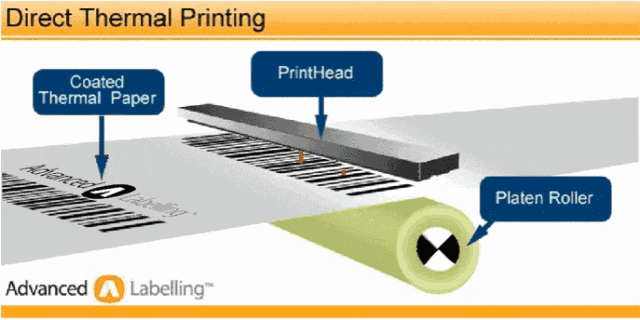
23. Thermal Transfer Printing
Thermal transfer printing works by first digitally printing the desired image onto transfer paper using specialized transfer ink in an inkjet printer. Then, a dedicated heat transfer machine applies high temperature and pressure to accurately transfer the image onto the surface of the product, completing the printing process.
AD:
Simple printing process with accurate positioning.
Does not cause damage to the material.
Suitable for printing images with color gradients and on multiple materials.
DIS:
Poor breathability.
Fine cracks may appear in the printed pattern on clothing when stretched.
Poor durability.
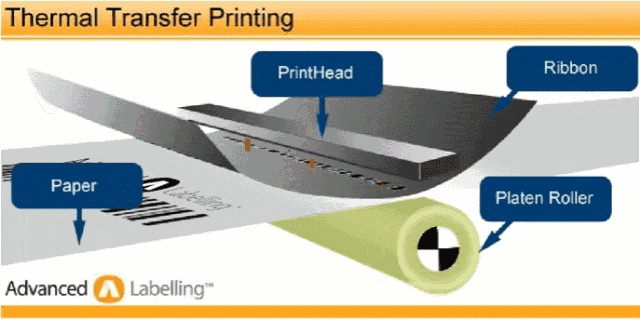
24. Planographic Printing
Planographic printing is a printing method that uses flat printing plates. It is the most widely used printing process globally and is also employed in the manufacturing of semiconductor and MEMS devices. Planographic printing, also referred to as “offset printing” or “indirect printing,” is a common commercial printing technology. It involves transferring images or text from flat printing plates onto rubber blankets, which are then used to print onto paper or other materials.
AD:
Fast printing speed, relatively low printing cost, and high print quality.
Suitable for large-scale and repeat printing jobs.
DIS:
Requires preparation of preliminary work such as plate making and setup.
Not suitable for short-run printing and customization.
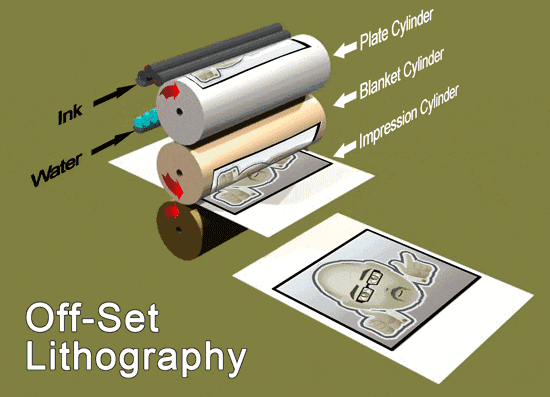

25. Curved Surface Printing
Curved surface printing involves placing ink into engraved plates with text or patterns, and then transferring them onto curved surfaces. The text or patterns are then transferred onto the surface of the molded product using the curved surface. Finally, methods such as heat treatment or ultraviolet light exposure are used to cure the ink.
AD:
Wide applicability: It can be used for printing on various curved surfaces, such as cylinders, spheres, and irregular shapes.
High customization: It can print complex patterns, text, and images on curved surfaces, achieving personalized customization.
High production efficiency, and stable quality.
DIS:
Higher cost due to the need for more equipment and technical support.
Subject to limitations of printing machinery and technology, some specific shapes of curved surfaces may not be fully covered.
Design complexity may increase as designers need to consider the variations and distortions of curved surfaces.
Ink curing in surface printing may be uneven or incomplete due to the influence of the surface shape.

26. Hot Stamping
Hot stamping refers to a process where hot stamping materials or hot stamping patterns are transferred onto objects such as paper, cardboard, fabric, or coated materials using heat and pressure. Hot stamping is commonly used in the binding process, especially on covers.
AD:
Precision and meticulous craftsmanship, with minimal equipment errors, resulting in finer patterns on hot-stamped items.
Capable of performing three-dimensional hot stamping.
Energy-efficient, reducing environmental pollution, and offering fast hot stamping speeds.
DIS:
The high precision requirement of the hot stamping process for equipment leads to increased costs.
The process involves relatively complex and intricate procedures.

26. Hot Stamping
Hot stamping refers to a process where hot stamping materials or hot stamping patterns are transferred onto objects such as paper, cardboard, fabric, or coated materials using heat and pressure. Hot stamping is commonly used in the binding process, especially on covers.
AD:
Precision and meticulous craftsmanship, with minimal equipment errors, resulting in finer patterns on hot-stamped items.
Capable of performing three-dimensional hot stamping.
Energy-efficient, reducing environmental pollution, and offering fast hot stamping speeds.
DIS:
The high precision requirement of the hot stamping process for equipment leads to increased costs.
The process involves relatively complex and intricate procedures.

26. Hot Stamping
Hot stamping refers to a process where hot stamping materials or hot stamping patterns are transferred onto objects such as paper, cardboard, fabric, or coated materials using heat and pressure. Hot stamping is commonly used in the binding process, especially on covers.
AD:
Precision and meticulous craftsmanship, with minimal equipment errors, resulting in finer patterns on hot-stamped items.
Capable of performing three-dimensional hot stamping.
Energy-efficient, reducing environmental pollution, and offering fast hot stamping speeds.
DIS:
The high precision requirement of the hot stamping process for equipment leads to increased costs.
The process involves relatively complex and intricate procedures.
27. Water Transfer Printing
Water transfer printing is a technique that transfers printed images or graphics from a flat surface onto the surface of different materials using water. It is divided into two types: water immersion transfer and water overlay transfer (curved surface overlay). Water immersion transfer is mainly used for transferring text and photographic images, while water overlay transfer is primarily used for complete transfer over the entire surface of an object.
AD:
Aesthetic appeal: It can transfer any natural patterns, photos, and graphics onto products.
Innovation: Water transfer printing technology can overcome the limitations of traditional printing methods such as heat transfer, offset printing, screen printing, and surface coating, allowing for the creation of complex shapes and angles.
Versatility: Applicable to surface printing on hardware, plastics, leather, glass, ceramics, wood, etc. (not suitable for fabric and paper).
Personalized design.
Efficiency: No need for plate-making; direct printing and immediate transfer.
DIS:
Transferred images or graphics are prone to deformation.
Fully manual operation leads to high labor costs and low production efficiency.
28. Flat Screen Printing
Flat screen printing involves fixing printing molds onto square frames, which are usually made of polyester or nylon mesh (screen) with hollow patterns. The patterned areas of the screen allow ink to pass through, while the non-patterned areas are sealed with a polymer film layer to block the mesh openings. During printing, the screen is pressed tightly against the fabric, ink is poured onto the screen, and a squeegee is used to repeatedly scrape and press the ink through the patterns onto the fabric surface.
AD:
Convenient plate-making process, with large repeat lengths, multiple color matching options, ability to print fine patterns without color bleeding, high ink volume, and the capability to achieve a three-dimensional effect. Suitable for printing on silk, cotton, synthetic fabrics, and knitted fabrics, especially for high-end fabrics with small batches and multiple variety requirements.
Hand scraping of the ink on the hot table allows for unlimited printing repeats.
DIS:
Due to the long distance between color frames, it is difficult to achieve overlapping colors.
Manual fabric placement, manual lifting of the frame, and hand scraping of the ink result in high labor intensity and uneven ink scraping.
The heat source for the hot table is typically steam heating, though some use electric heating, which consumes a lot of electricity and is prone to accidents.
29. Calendering
Calendering, also known as pressing, is the final process of finishing leather. It involves using the plasticity of fibers under heated conditions to flatten or create parallel fine diagonal lines on the surface of the fabric, enhancing the gloss of the fabric. This process is typically carried out using a swing calender machine or a bottom leather rolling machine. Usually, it involves two passes: the first pass compresses the leather body, done after even wetting, followed by stacking to balance moisture content. The second pass is for calendering, which results in a smooth and glossy leather surface with a compacted leather body, thus achieving the finished leather.
Conclusion
With such an array of surface treatment processes available, navigating through their definitions and intricacies can be daunting. However, this blog streamlines the information by organizing definitions and process diagrams, making it effortless to grasp the various surface treatment techniques in just a few minutes. Each method’s advantages and disadvantages are neatly presented, enabling a quick understanding of their applications, efficiencies, and limitations.
0 notes
Text
Underfilm Corrosion: The Hidden Threat Beneath Coatings
Protective coatings play a crucial role in safeguarding metal structures from corrosion, offering a shield against environmental stresses such as moisture, chemicals, UV radiation, and mechanical abrasion. Despite their importance, coatings can be vulnerable to failures, particularly from a less visible threat known as underfilm corrosion, which can undermine the structural integrity and longevity of coated systems.

Understanding Underfilm Corrosion
Underfilm corrosion refers to the insidious deterioration of metal substrates occurring beneath protective coatings. This form of corrosion typically initiates at defects or areas of poor adhesion within the coating system. Unlike surface corrosion, which is readily observable, underfilm corrosion operates discreetly, leading to significant damage before detection.
Causes of Underfilm Corrosion
Coating Defects: Inadequate surface preparation, improper coating application, or mechanical damage can create voids, pinholes, or cracks in the coating, exposing the underlying metal to corrosive elements.
Moisture Entrapment: Trapped moisture within the coating film can act as an electrolyte, facilitating electrochemical corrosion reactions on the metal surface.
Ionic Contaminants: Residual salts, chlorides, or other ionic contaminants on the substrate can accelerate corrosion processes, particularly in the presence of moisture.
Differential Oxygen Concentration: Variations in oxygen concentration beneath the coating film can create localized corrosion cells, leading to accelerated metal degradation.
Chemical Attack: Exposure to aggressive chemicals can compromise the protective properties of coatings, allowing corrosion to initiate underneath.
Manifestations of Underfilm Corrosion
Blistering: Underfilm corrosion can cause the formation of blisters or bubbles on the coating surface, indicating trapped corrosion byproducts.
Peeling/Delamination: Loss of adhesion between the coating and substrate can result in visible peeling or flaking of the coating.
Localized Pitting: Corrosion pits may form beneath the intact coating, often leading to widespread metal loss over time.
Preventive Strategies
Preventing underfilm corrosion necessitates a comprehensive approach that addresses both coating application and environmental considerations:
Thorough Surface Preparation: Proper cleaning, degreasing, and profiling of the substrate are critical to achieving strong adhesion and minimizing defects.
Quality Coating Selection: Choose coatings designed for specific environmental exposures, considering factors such as chemical resistance, UV stability, and adhesion properties.
Application Best Practices: Adhere strictly to manufacturer specifications regarding temperature, humidity, and film thickness during application.
Regular Inspection and Maintenance: Implement routine inspections to detect early signs of coating degradation or defects, enabling prompt repairs before corrosion advances.
Environmental Controls: Minimize exposure to moisture, salts, and aggressive chemicals that can compromise coating integrity.
Case Study: Underfilm Corrosion in Infrastructure
Consider a scenario where a bridge structure is coated with a protective layer to guard against environmental corrosion. Over time, undetected defects in the coating allow moisture ingress, initiating corrosion on the underlying steel. Without intervention, this hidden corrosion weakens the structure, posing safety risks and requiring costly repairs.
Conclusion
Underfilm corrosion poses a significant and often overlooked threat to coated metal systems. By understanding the causes, manifestations, and preventive measures associated with underfilm corrosion, asset owners and maintenance professionals can mitigate risks and prolong the service life of critical infrastructure. Vigilant surface preparation, appropriate coating selection, and proactive maintenance are essential pillars in combating this hidden menace beneath protective coatings.
0 notes
Text
Improving Precision with Hg/HgO Reference Electrodes
In electrochemical studies, reference electrodes play a crucial role by providing a consistent potential that serves as a benchmark for assessing the potential of the working electrode. They serve as the standard for ascertaining the electrochemical potential of the system under investigation. The mercury/mercury (II) oxide (Hg/HgO) electrode is a commonly used reference electrode that is renowned for its dependability and adaptability in a wide range of electrochemical applications.

Reference electrodes are the fundamental basis for electrochemical measurements.
Reference electrodes generally have a steady and consistent electrode potential, remaining unchanged regardless of the experimental settings. Materials with established and consistent electrode potentials, such as saturated calomel electrodes (SCE) or silver-silver chloride electrodes (Ag/AgCl), commonly construct these electrodes. These electrodes provide a consistent reference potential for measuring the potential of the working electrode.
The Hg/HgO Reference Electrode's Specialized Applications and Advantages
People frequently use the Hg/HgO reference electrode, a specific type of reference electrode, in situations that require exceptional stability and minimal upkeep. The setup consists of a pool of mercury in contact with a layer of mercury (II) oxide, which serves as the electrolyte's interface. The Hg/HgO electrode provides various benefits, such as reduced impedance, a broad potential range, and immunity to contamination.
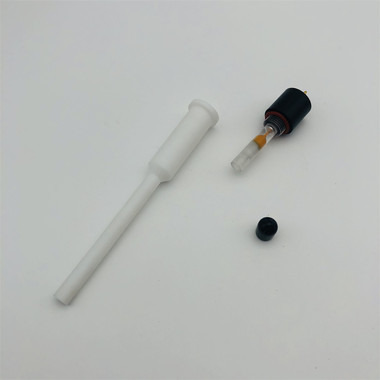
Utilization of Hg/HgO Reference Electrodes
Electrochemical research extensively uses Hg/HgO reference electrodes, particularly in situations where conventional reference electrodes may not be acceptable. Tests conducted under conditions of elevated temperature and pressure, as well as in caustic or aggressive electrolytes, frequently employ them. Applications such as analytical chemistry and sensor development, where precise potential measurements are crucial, prefer Hg/HgO electrodes.
Ultimately, Dek Research plays a pivotal role in propelling scientific pursuits forward by providing cutting-edge solutions and specialized knowledge in the field of research and development. By prioritizing excellence and utilizing state-of-the-art technology, we enable enterprises to accomplish their objectives and advance in diverse domains. For innovative research solutions, turn to Dek Research.
0 notes
Text
Elastic Battery Binders Market to Expand at a CAGR of 16.6% from 2022 to 2031
The elastic battery binders market to cross a valuation of US$ 1.4 Bn by 2031. Excellent elasticity for high-performance silicon anodes in lithium-ion batteries to power electric vehicles fuels the growth of the elastic battery binders market. This is attracting leading players in the elastic battery binders market to develop new and highly elastic battery binders for various purposes such as overcoming stress dissipation of silicon anodes during the charge-discharge cycle of lithium-ion batteries.
Besides this, numerous uses of a range of products for their superior physical properties provide impetus to the elastic battery binders market. For instance, polyurethane (PU) exhibits high tensile strength, elasticity, and adhesion compared to common aqueous binders to find numerous uses such as hybrid aqueous elastic binders.
Get PDF Brochure for More Insights – https://www.transparencymarketresearch.com/sample/sample.php?flag=S&rep_id=84840
Significance of polymer binder materials for the growing demand for electrochemical energy storage devices to provide ample opportunities to elastic battery binders market. Innovative polymer binder materials that are modelled on fundamental understanding of physical phenomenon and structure-property relationships are required for high-capacity next-generation battery chemistries. For example, exponential rise in demand for lithium-ion batteries for energy supply in portable electronic products compels need for high-performance anodes to replace conventional carbon-based anodes to serve the increase in energy output.
Asia Pacific held a significant 74.6% share of elastic battery binders market in 2021, and is anticipated to continue to remain a key region during the forecast period.
Market Segmentation:
By Service Type: Product development, customization, maintenance, and consulting services.
By Sourcing Type: In-house production, outsourcing, and partnerships.
By Application: Electric vehicles, consumer electronics, renewable energy storage, and industrial applications.
By Industry Vertical: Automotive, electronics, energy & power, and manufacturing.
By Region: North America, Europe, Asia Pacific, Latin America, and Middle East & Africa.
Regional Analysis: Asia Pacific is expected to dominate the elastic battery binders market due to the presence of major battery manufacturers and increasing investments in EV infrastructure. North America and Europe are also significant markets, driven by the shift towards clean energy solutions and stringent environmental regulations.
Market Drivers and Challenges:
Drivers: Growing demand for electric vehicles, renewable energy integration, advancements in battery technologies, and government incentives for sustainable energy solutions.
Challenges: High initial investment costs, technical complexities in binder formulation, and fluctuating raw material prices.
Market Trends:
Focus on Sustainability: Manufacturers are increasingly focusing on developing eco-friendly binders to align with environmental regulations and consumer preferences.
Integration of Nanotechnology: Nanomaterials are being incorporated into binder formulations to enhance battery performance, stability, and safety.
Partnerships and Collaborations: Key players are forming strategic alliances with research institutions and battery manufacturers to innovate and expand their market presence.
Future Outlook: The elastic battery binders market is poised for steady growth driven by technological advancements, rising demand for energy storage solutions, and supportive government policies promoting sustainable energy practices globally.
Key Market Study Points:
Market Size and Forecast
Market Dynamics (Drivers, Challenges, Opportunities)
Competitive Landscape Analysis
Regional Analysis
Market Segmentation
Industry Trends and Developments
Competitive Landscape: Major players in the elastic battery binders market include BASF SE, Solvay SA, DuPont de Nemours, Inc., Arkema SA, and Mitsubishi Chemical Corporation, among others. These companies are focusing on research and development activities, product innovation, and strategic partnerships to gain a competitive edge in the market.
Buy this Premium Research Report: https://www.transparencymarketresearch.com/checkout.php?rep_id=84840<ype=S
Recent Developments:
BASF SE introduced a new range of eco-friendly binders for lithium-ion batteries, enhancing their sustainability profile.
DuPont de Nemours, Inc. collaborated with a leading EV manufacturer to develop customized battery binders for high-performance electric vehicles.
About Transparency Market Research
Transparency Market Research, a global market research company registered in Wilmington, Delaware, United States, provides custom research and consulting services. Our exclusive blend of quantitative forecasting and trends analysis provides forward-looking insights for thousands of decision-makers. Our experienced team of Analysts, Researchers, and Consultants use proprietary data sources and various tools & techniques to gather and analyze information.
Our data repository is continuously updated and revised by a team of research experts, so that it always reflects the latest trends and information. With a broad research and analysis capability, Transparency Market Research employs rigorous primary and secondary research techniques in developing distinctive data sets and research material for business reports.
Contact:
Transparency Market Research Inc.
CORPORATE HEADQUARTER DOWNTOWN,
1000 N. West Street,
Suite 1200, Wilmington, Delaware 19801 USA
Tel: +1-518-618-1030
USA – Canada Toll Free: 866-552-3453
Website: https://www.transparencymarketresearch.com
0 notes
Text
Unleashing Innovation: The Evolution of Zinc-Air Battery Technology

In recent years, Zinc-Air Battery technology has undergone significant advancements, driving innovation in the field of energy storage. From its humble beginnings to its current state of development, Zinc-Air Batteries have evolved to become a promising solution for addressing the world's energy storage needs. Let's delve into the evolution of Zinc-Air Battery technology and the groundbreaking innovations that have propelled its growth.
Pioneering Research and Development
The journey of Zinc-Air Battery technology began with pioneering research and development efforts aimed at understanding the fundamental principles of its electrochemical reaction.
Early studies laid the groundwork for harnessing the power of zinc and air to generate electrical energy efficiently and sustainably.
Advancements in Electrode Design
A significant milestone in the evolution of Zinc-Air Battery technology was the development of innovative electrode designs.
Researchers focused on optimizing electrode materials and structures to enhance energy efficiency, stability, and longevity, leading to substantial improvements in battery performance.
Breakthroughs in Catalyst Development
Catalysts play a crucial role in facilitating the electrochemical reactions within Zinc-Air Batteries.
Breakthroughs in catalyst development have enabled researchers to enhance reaction kinetics, minimize overpotential, and improve overall battery efficiency, paving the way for commercial viability.
Scalability and Commercialization Efforts
As Zinc-Air Battery technology matured, efforts were directed toward scaling up production and commercialization.
Manufacturers invested in scalable production processes and quality control measures to meet the growing demand for Zinc-Air Batteries across various applications, from portable electronics to electric vehicles and grid-scale energy storage.
Integration with Smart Grid Technologies
The integration of Zinc-Air Battery technology with smart grid technologies has unlocked new possibilities for energy management and grid stability.
By incorporating advanced monitoring and control systems, Zinc-Air Batteries can respond dynamically to fluctuating energy demands and optimize energy storage and distribution in real-time.
Addressing Environmental Concerns
Sustainability is a key focus in the evolution of Zinc-Air Battery technology.
Researchers are exploring eco-friendly alternatives for electrode materials and electrolytes, as well as developing recycling processes to minimize environmental impact and promote the circular economy.
Get More Insights On This Topic: Zinc-Air Battery
#Zinc-Air Battery#Energy Storage#Renewable Energy#Battery Technology#Sustainable Power#Electrochemistry#Power Generation#Environmental Innovation
0 notes
Text
0 notes
Text
The Rise Of Sodium Batteries In South Korea
Introduction:
In the quest for sustainable energy solutions, South Korea stands at the forefront of innovation, continually pushing the boundaries of scientific discovery. Recently, the spotlight has turned to a remarkable advancement in battery technology: the emergence of sodium batteries. Representing a promising alternative to conventional lithium-ion batteries, sodium batteries have captured the imagination of researchers and industry experts alike. In this article, we’ll delve into the fascinating world of sodium batteries and explore how South Korea is spearheading their development, paving the way for a greener, more sustainable future.
A Promising Alternative To Lithium-ion Technology :
As global energy demand surges and renewable energy adoption rises, lithium-ion batteries (LIBs) have cemented their role as essential components of our modern lives. Yet, the finite nature of lithium resources and its escalating costs have sparked sustainability worries surrounding LIBs. Enter sodium-ion batteries (SIBs), emerging as a viable alternative. SIBs tout numerous advantages, boasting abundant, safe raw materials and a chemistry akin to the well-established LIB technology. Nonetheless, despite these merits, several hurdles hinder the widespread commercialization of SIBs.
Understanding Sodium Batteries:
At the heart of sodium batteries lies a simple yet revolutionary concept: harnessing the power of sodium ions to store and deliver energy. Unlike lithium-ion batteries, which rely on scarce and expensive lithium resources, sodium batteries utilize sodium, a more abundant and cost-effective element. By leveraging sodium’s electrochemical properties, researchers have unlocked a new frontier in energy storage, offering a promising solution to the growing demand for sustainable battery technology.
Key Advantages and Benefits:
The rise of sodium batteries brings with it a host of compelling advantages and benefits. Firstly, sodium is abundant and widely available, reducing concerns about resource scarcity and price volatility. This abundance translates into lower production costs, making sodium batteries a more cost-effective alternative to lithium-ion batteries. Additionally, sodium batteries boast higher energy density and improved safety compared to their lithium counterparts, offering enhanced performance and reliability in various applications.
South Korea’s Leadership and Innovation:
South Korea has emerged as a global leader in sodium battery research and development, with its renowned institutions and industry players at the forefront of innovation. Korean researchers have made significant strides in overcoming technical challenges and optimizing sodium battery performance, paving the way for commercialization and widespread adoption. Collaborative efforts between academia, government agencies, and private enterprises have accelerated progress in sodium battery technology, positioning South Korea as a hub of excellence in the field.
Applications and Potential Impact:
The potential applications of sodium batteries are vast and varied, spanning from electric vehicles and renewable energy storage to grid-level energy management and portable electronics. With their superior energy density, safety, and cost-effectiveness, sodium batteries have the potential to reshape entire industries and drive the transition towards a more sustainable energy future. By enabling longer-range electric vehicles, grid stabilization with renewable energy integration, and reliable off-grid power solutions, sodium batteries promise to revolutionize the way we generate, store, and consume energy.
Future Outlook and Challenges:
While the future looks bright for sodium batteries, challenges remain on the path to widespread adoption. Scaling up production, optimizing performance, and addressing concerns about longevity and recyclability are among the key hurdles that researchers and industry stakeholders must overcome. However, with continued investment, innovation, and collaboration, these challenges can be addressed, unlocking the full potential of sodium batteries to power a cleaner, greener world.
Conclusion:
The rise of sodium batteries marks a significant milestone in the quest for sustainable energy solutions, offering a compelling alternative to conventional lithium-ion batteries. With South Korea leading the charge in research, development, and commercialization, sodium batteries hold the promise of a brighter, more sustainable future. As the world transitions towards a low-carbon economy, sodium batteries are poised to play a pivotal role in powering tomorrow’s innovations and driving positive change on a global scale.
0 notes
Text

From 2D to 3D: MXene's path to revolutionizing energy storage and more
With a slew of impressive properties, transition metal carbides, generally referred to as MXenes, are exciting nanomaterials being explored in the energy storage sector. MXenes are two-dimensional materials that consist of flakes as thin as a few nanometers.
Their outstanding mechanical strength, ultrahigh surface-to-volume ratio, and superior electrochemical stability make them promising candidates as supercapacitors—that is, as long as they can be arranged in 3D architectures where there is a sufficient volume of nanomaterials and their large surfaces are available for reactions.
During processing, MXenes tend to restack, compromising accessibility and impeding the performance of individual flakes, thereby diminishing some of their significant advantages. To circumvent this obstacle, Rahul Panat and Burak Ozdoganlar, along with Ph.D. candidate Mert Arslanoglu, from the Mechanical Engineering Department at Carnegie Mellon University, have developed an entirely new material system that arranges 2D MXene nanosheets into a 3D structure.
Read more.
7 notes
·
View notes
Text
Harnessing the Power of Nanotechnology in Dentistry: Advancements and Applications

Nanotechnology, the manipulation of matter at the nanoscale, has emerged as a game-changing field with transformative potential across various industries, including healthcare. In dentistry, nanotechnology is revolutionizing the way oral health conditions are diagnosed, treated, and managed. By leveraging the unique properties of nanomaterials, researchers and dental professionals are developing innovative solutions to address a wide range of dental challenges. Let's delve into the advancements and applications of nanotechnology in dentistry:
Nanomaterials for Restorative Dentistry:
Nanotechnology has paved the way for the development of advanced dental materials with enhanced properties for restorative procedures. Nanocomposites, composed of nano-sized fillers such as silica nanoparticles and nanoclays embedded in a resin matrix, exhibit superior mechanical strength, wear resistance, and aesthetic properties compared to traditional dental materials.
These nanocomposites enable dentists to create durable and aesthetically pleasing restorations, such as fillings, crowns, and veneers, that closely mimic the natural appearance and function of teeth. Additionally, nanomaterials can release bioactive agents, such as fluoride or calcium ions, to promote remineralization and strengthen tooth structure, offering long-term benefits for patients' oral health.
Nanostructured Biomaterials for Tissue Engineering:
Nanotechnology holds tremendous potential in tissue engineering and regenerative dentistry by facilitating the development of nanostructured biomaterials that promote the regeneration of dental tissues. Scaffold materials engineered at the nanoscale provide an ideal environment for cell attachment, proliferation, and differentiation, facilitating the regeneration of dental pulp, periodontal ligaments, and bone tissues.
Nanofibrous scaffolds, electrospun from biocompatible polymers such as collagen or hydroxyapatite, mimic the natural extracellular matrix of dental tissues and support the growth of regenerative cells. These nanostructured biomaterials can be combined with growth factors, stem cells, or bioactive molecules to accelerate tissue regeneration and repair damaged or diseased dental tissues effectively.
Nanoparticle-Based Drug Delivery Systems:
Nanotechnology enables precise control over drug delivery systems for targeted and controlled release of therapeutic agents in the oral cavity. Nanoparticles, such as liposomes, polymeric nanoparticles, and dendrimers, can encapsulate drugs, antimicrobial agents, or bioactive molecules and deliver them to specific sites within the oral cavity with enhanced efficiency and efficacy.
In dentistry, nanoparticle-based drug delivery systems hold promise for the treatment of various oral conditions, including dental caries, periodontal diseases, and oral infections. By delivering therapeutic agents directly to the affected tissues while minimizing systemic side effects, these nanocarriers improve treatment outcomes and reduce the risk of antimicrobial resistance.
Nanostructured Surfaces for Dental Implants:
Surface modifications at the nanoscale have been shown to significantly enhance the osseointegration and long-term stability of dental implants. Nanostructured implant surfaces, engineered to mimic the topography of natural bone, promote faster bone healing and implant integration, leading to improved implant success rates and reduced healing times.
Nanotextured surfaces created through techniques such as plasma spraying, acid etching, or electrochemical deposition increase surface roughness and surface energy, facilitating better cell adhesion and bone formation. By optimizing the biological response at the implant-bone interface, nanostructured surfaces enhance the biomechanical stability and longevity of dental implants, ultimately improving patient outcomes.
Nanodiagnostic Tools for Early Disease Detection:
Nanotechnology offers innovative solutions for early disease detection and diagnosis in dentistry through the development of sensitive and specific nanodiagnostic tools. Nanomaterial-based biosensors, such as quantum dots, carbon nanotubes, and gold nanoparticles, can detect biomarkers associated with dental diseases, including caries, periodontitis, and oral cancers, with high accuracy and sensitivity.
These nanodiagnostic tools enable early detection of oral health conditions at the molecular level, allowing for timely intervention and personalized treatment strategies. By facilitating early diagnosis and monitoring of disease progression, nanotechnology-based biosensors contribute to improved patient outcomes and better overall oral health.
Conclusion:
In conclusion, nanotechnology represents a transformative force in dentistry, offering innovative solutions to address diverse oral health challenges. From advanced restorative materials and tissue engineering scaffolds to targeted drug delivery systems and diagnostic tools, nanotechnology is reshaping the future of oral healthcare. As research in this field continues to advance, the integration of nanotechnology into clinical practice holds tremendous promise for enhancing treatment outcomes, improving patient experiences, and ultimately advancing the field of dentistry. To know more visit us today!
0 notes
Text
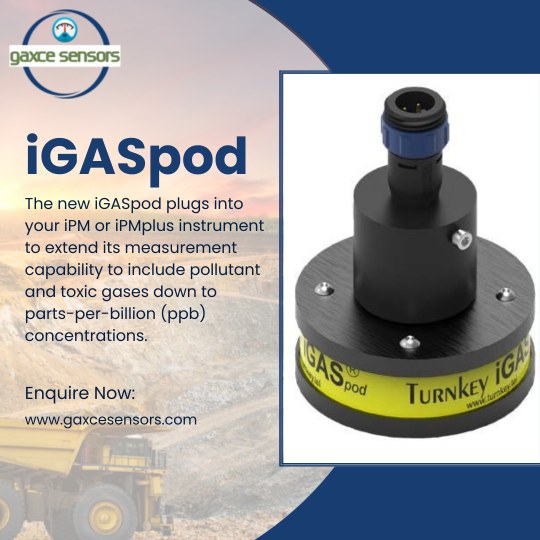
Exciting news! Introducing our latest innovation: the iGASpod!
Seamlessly enhance your iPM or iPMplus instrument with extended measurement capabilities, now including pollutant and toxic gases down to parts-per-billion (ppb) concentrations.
With multiple high-stability electrochemical cells and an optional 10.6 eV photoionization detector for VOCs, the iGASpod takes your analysis to the next level.
Contact for more information:
Phone: +91-9673123829
Email: [email protected]
For more details visit - https://gaxcesensors.com/
0 notes
Text
1,3,6-HEXANETRICARBONITRILE CAS#: 1772-25-4

IdentificationPhysical DataSpectraRoute of Synthesis (ROS)Safety and HazardsOther Data
Identification
Product Name1,3,6-HEXANETRICARBONITRILEIUPAC Namepyridihexane-1,3,6-tricarbonitrileMolecular StructureCAS Registry Number 1772-25-4MDL NumberMMFCD00131222Synonyms1,3,6-Hexanetricarbonitrile1772-25-4hexane-1,3,6-tricarbonitrile1,3,6-TRICYANOHEXANE4-CyanosuberonitrileSJY3YNQ3SIDTXSID4041234HSDB 5855UNII-SJY3YNQ3SIEINECS 217-199-7(+/-)-1,3,6-HEXANETRICARBONITRILE, TECH. , 80+%SCHEMBL1323168CHEMBL3183751DTXCID2021234BAA77225Tox21_300976MFCD00129792AKOS0221827011,3,6-TRICYANOHEXANE s12371NCGC00248239-01NCGC00254878-01BS-21827CAS-1772-25-4CS-0198995H1504NS00025841Q27289244Molecular FormulaC9H11N3Molecular Weight161.2InChIInChI=1S/C9H11N3/c10-6-2-1-4-9(8-12)5-3-7-11/h9H,1-5H2InChI KeyLNLFLMCWDHZINJ-UHFFFAOYSA-NIsomeric SMILESC(CC#N)CC(CCC#N)C#N
Patent InformationPatent IDTitlePublication DateCN115784927Preparation method of alkane trinitrile2023US2021/408602ELECTROLYTE AND ELECTROCHEMICAL DEVICE2021US4128571Thermal conversion of 4-cyano-suberonitrile to acrylonitrile1978US5132427Process for the preparation of amines1992
Physical Data
AppearanceLight yellow to yellow oily liquid
Boiling Point, °CPressure (Boiling Point), Torr186 - 2000.2
Spectra
Description (NMR Spectroscopy)Nucleus (NMR Spectroscopy)Solvents (NMR Spectroscopy)Frequency (NMR Spectroscopy), MHzChemical shifts1Hchloroform-d1Chemical shifts13Cchloroform-d1Chemical shifts1Hchloroform-d1400
Route of Synthesis (ROS)
Route of Synthesis (ROS) of 1,3,6-Hexanetricarbonitrile CAS 1772-25-4
ConditionsYieldWith water; sodium chloride In dimethyl sulfoxide at 160℃; Reagent/catalyst; Temperature; Solvent;Experimental Procedure4-8 Preparation of 1,3,6-hexane trinitrileTake 50 grams of 2,5-dicyano-2-cyanoethyl-pentanoic acid ethyl ester prepared in Example 1, add 100 grams of DMSO, add 8 grams of water, 2.5 grams of NaCl, and raise the temperature to 160°C.After the gas no longer overflowed, the DMSO and water were removed by concentration under reduced pressure, and then the distillation was continued to obtain a product of 1 mmHg, a fraction at 195-196°C of 32.0 g, a yield of 92.8%, and a GC purity of 99.5%.92.8%
Safety and Hazards
Pictogram(s)SignalWarningGHS Hazard StatementsH302 (97.62%): Harmful if swallowed H332 (92.86%): Harmful if inhaled Precautionary Statement CodesP261, P264, P270, P271, P301+P317, P304+P340, P317, P330, and P501(The corresponding statement to each P-code can be found at the GHS Classification page.)
Other Data
TransportationUnder the room temperature and away from lightHS CodeStorageUnder the room temperature and away from lightShelf Life1 yearMarket Price
DruglikenessLipinski rules componentMolecular Weight161.206logP0.107HBA3HBD0Matching Lipinski Rules4Veber rules componentPolar Surface Area (PSA)71.37Rotatable Bond (RotB)5Matching Veber Rules2
Use Pattern1,3,6-HEXANETRICARBONITRILE CAS#: 1772-25-4 is an important electrolyte additive, and the composition of the electrolyte restricts the application of positive and negative electrode materials at high voltages. Traditional organic carbonates, such as linear carbonates like DEC, DMC, EMC, and cyclic carbonates like PC, EC, tend to undergo decomposition at high voltages . Therefore, the development of novel organic solvents with a wide electrochemical window, high lithium salt solubility, and low toxicity has become a key focus in the development of high-voltage electrolytes. Nitrile-based organic solvents typically possess a wide electrochemical window, high anodic stability, low viscosity, and high boiling points, among other excellent characteristics . Additionally, the decomposition products of solvents containing nitrile groups are generally carboxylates, aldehydes, or corresponding organic amines, eliminating the generation of toxic CN- ions during usage . Nitrile solvents demonstrate a broad electrochemical window and are considered promising new organic solvents. However, in terms of the electrochemical performance of lithium-ion batteries, nitrile solvents still face compatibility issues with the negative electrode. The formation of a mixed system with carbonate solvents or the addition of mixed salts like LiBOB can partially alleviate this issue.
Read the full article
0 notes
Text
Powering the Future: Insights into the Membrane Electrode Assembly Market
In the pursuit of sustainable energy solutions, hydrogen fuel cells have emerged as a promising technology with the potential to revolutionize power generation and transportation. At the heart of hydrogen fuel cells lies the membrane electrode assembly (MEA), a critical component that facilitates the conversion of hydrogen and oxygen into electricity. This article explores the significance of MEAs, their applications, and the evolving landscape of the market.
MEA is a key component of proton exchange membrane fuel cells (PEMFCs), which are one of the most common types of hydrogen fuel cells used for stationary power generation, automotive propulsion, and portable electronics. The MEA consists of several layers, including a proton exchange membrane (PEM), catalyst layers, and gas diffusion layers, sandwiched between two electrodes—a hydrogen electrode (anode) and an oxygen electrode (cathode).
The primary function of the MEA is to facilitate the electrochemical reactions that occur within the fuel cell, namely the oxidation of hydrogen at the anode and the reduction of oxygen at the cathode. This process generates an electric current that can be used to power electric motors, vehicles, and electronic devices, with water vapor as the only byproduct.
Request the sample copy of report @ https://www.globalinsightservices.com/request-sample/GIS21995
One of the key attributes of MEAs is their efficiency in converting chemical energy into electrical energy, with high power density and low operating temperatures compared to other types of fuel cells. This makes PEMFCs and MEAs particularly well-suited for applications requiring clean, quiet, and reliable power generation, such as fuel cell vehicles, backup power systems, and off-grid power supply.
Moreover, MEAs offer scalability and versatility, allowing for customization and optimization to meet the specific requirements of different applications and operating conditions. Advances in materials science, manufacturing techniques, and catalyst formulations have led to improvements in MEA performance, durability, and cost-effectiveness, driving the widespread adoption of hydrogen fuel cell technology.
The market for MEAs is experiencing rapid growth and expansion, driven by increasing demand for clean energy solutions, government incentives and subsidies for fuel cell deployment, and advancements in hydrogen production and infrastructure. Automotive manufacturers, energy companies, and electronics manufacturers are investing heavily in research and development to commercialize hydrogen fuel cell vehicles and portable fuel cell devices, further stimulating market growth.
Moreover, the transition towards renewable energy sources and decarbonization efforts are creating new opportunities for MEAs in stationary power generation, grid stabilization, and energy storage applications. As governments and industries worldwide strive to reduce greenhouse gas emissions and mitigate the impacts of climate change, hydrogen fuel cells and MEAs are poised to play a significant role in powering the transition to a sustainable energy future.
In conclusion, MEAs are critical components of hydrogen fuel cells, offering efficient, clean, and reliable power generation solutions for a wide range of applications. With ongoing advancements in technology and increasing adoption of hydrogen fuel cell technology, the market for MEAs is poised for continued growth and innovation, driving the transition towards a more sustainable and resilient energy landscape.
0 notes